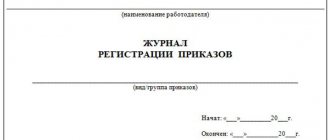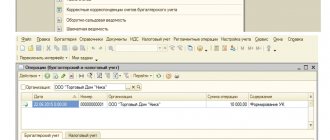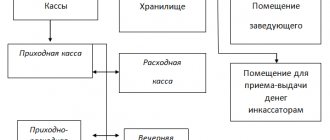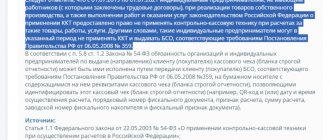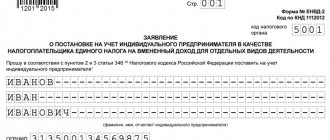Magazine KO-3
The journal for registering incoming and outgoing cash orders (form KO-3) records the primary accounting documents of cash circulation of funds.
The requirement for public sector organizations to reflect them in the registration book is enshrined in Order of the Ministry of Finance dated March 30, 2015 No. 52n. For non-public sector organizations, including non-profit organizations, it is not necessary to use the form (No. 402-FZ). But if an organization decides to use it, it is necessary to consolidate this in its accounting policies.
The form of the book was approved by Resolution of the State Statistics Committee of August 18, 1998 No. 88 and determined by the unified form code 0310003.
Is it necessary to maintain PKO and RKO for accounting purposes?
The need for registration and accounting of incoming and outgoing cash orders is often associated with the need to monitor the relevant documents over time.
In addition, the practice of maintaining such accounting allows you to clearly demonstrate to the tax service the correctness of all cash transactions carried out by the enterprise.
This feature often turns out to be useful during audits carried out by the fiscal authority.
As for the mandatory maintenance of a journal for registering incoming and outgoing cash orders, such a regulatory requirement was in effect for business entities working with cash until the end of 2011.
This instruction was regulated by the Procedure for carrying out cash transactions in the Russian Federation (clause 21), approved by the Central Bank of the Russian Federation (No. 40 of September 22, 1993).
Subsequently, this regulatory document ceased to apply. It was replaced by the Regulations of the Central Bank of the Russian Federation, regulating the procedure for making cash transactions with banknotes and coins on the territory of the Russian Federation, approved by the Central Bank of the Russian Federation (No. 373-P dated 10/12/2011) and which came into force on 01/01/2012.
The new regulatory act of the Bank of Russia - Regulation No. 373-P dated October 12, 2011 - no longer requires the need to maintain this journal.
Currently, you should adhere to the procedure for cash transactions regulated by the Directive of the Central Bank of the Russian Federation under number 3210-U dated March 11, 2014.
This regulatory document also does not provide for the mandatory maintenance by enterprises (business entities) of a registration journal for cash orders.
Regulation No. 373-P (clause 5.2) provides for the need to reflect information about PKO and RKO exclusively in the cash book.
However, when conducting audits, the tax service often requires business entities to provide for audit not only cash books and other papers related to cash transactions, but also a journal of registration and accounting of PKOs and RKOs.
Thus, if a company regularly and frequently engages in significant cash transactions, it is still recommended that it maintain this ledger.
What form should I use?
The registration journal, intended for recording issued cash orders (PKO and RKO), can be maintained by an enterprise using a unified form No. KO-3, the form of which is purposefully developed and regulated by the State Statistics Committee of the Russian Federation (Resolution No. 88 of 08/18/1998).
Form KO-3 cannot be considered the only one possible for use. In essence, this document is a consolidated register of general accounting.
Accordingly, an economic entity can choose to either use a regulated form or develop its own journal for this purpose, focusing, for example, on a standard form.
The possibility of such a choice is provided to the enterprise by the norms of the current legislation (meaning Federal Law-402 - on accounting).
The entity responsible for accounting in the organization has the right to develop consolidated registers of an enterprise, and they are approved by administrative acts of the manager.
How to fill out form KO-3?
The standard form of such a journal is represented by a table consisting of two parts. On the left side information about PKO is reflected, on the right side - about RKO.
Cash orders are recorded in the registration journal displaying the following data:
- transaction amount;
- date of the operation;
- number assigned to the order upon registration;
- note, brief description of the incoming/outgoing transaction.
In addition, the title page indicates the name of the organization, the name of the structural unit, the registration code of the enterprise, the accounting period, and the responsible entity (full name, position).
filling out f. 0310003
journal of accounting and registration of PKO and RKO form KO-3 – excel.
filling out form KO-3 – excel.
What to include in form KO-3
When handling primary accounting documents for cash accounting, you must follow the instructions of the Bank of Russia:
- dated 10/07/2013 No. 3073-U on the procedure for making cash payments;
- dated March 11, 2014 No. 3210-U on conducting cash transactions for accepting cash.
It is necessary to keep records of all “primary” documents that are drawn up when handling cash:
- cash receipt orders (PKO);
- expense cash orders (RKO).
Be sure to include the following information:
- order number;
- date;
- amount;
- notes.
Filling out the log
- In the line “organization” the full name of the company is written, indicating the organizational form.
- In the line below, write the code and name of the branch. If this is not available, put a dash.
- In the column “OKPO code” indicate the corresponding code.
- In the center of the page is written the period of time for which the magazine is designed. Next to it is written the position and initials of the employee who fills out the log.
- Loose-leaf sheets are filled out according to the following principle: documents are indicated on the left by receipt, and on the right - by expense. Be sure to indicate the amounts.
- The “note” column is intended to indicate the basis for the operation being performed.
Filling out a cash register, sample
It is allowed to keep a journal both using technical means (that is, in electronic form) and in paper form. If the journal is kept in paper form and filled out by hand, you should remember that all its pages must be numbered, stitched with thread and certified with a signature.
Let's look at how to fill out a cash register using an example.
Conventionally, the process can be divided into two parts: filling out the title page and the accounting table.
Step 1. Fill out the title page.
We indicate the name of the organization. If there are no structural divisions, a dash is added. We write code using OKPO according to statistics.
Step 2. We register the period for which records are kept. Also the position and full name of the responsible person.
Next, fill out the tabular part.
Each sheet is divided into two parts: on the left side – registration of receipt orders (RPO); on the right - expense orders (RKO). They are filled in the same way.
Step 3. Fill in the date and serial number of the receipt or expense document.
Step 4. We write down the amount indicated in the document.
Step 5. In the note we briefly indicate the information from whom the money was received or to whom the money was issued, as well as the basis for this.
IMPORTANT!
Corrections and absence of required entries are unacceptable!
Journal of registration of incoming and outgoing cash documents
The cash register journal is an accounting journal necessary for registering cash documents before they are transferred to the cash officer.
It is necessary to register the following documents:
- Receipt and expense orders;
- Applications for cash withdrawal;
- Invoices for payment;
- Salary statements.
This journal is filled out either by a cashier or an accountant. They should remember that documents such as salary slips are registered immediately after payments are made. The remaining documents are subject to registration before payment or receipt of money.
Do you need a cash register for online cash registers?
In terms of functionality, this is the same device as before, which prints checks and stores information about them. But only now, online cash registers (including when renting an online cash register) need access to the Internet in order to transmit information about completed transactions to the tax office. There is also such a function as sending a receipt to the buyer by email.
Now, thanks to the innovative online cash register, many documents that were approved in the State Statistics Committee Resolution No. 132 dated December 25, 1998 do not need to be used. But this does not apply to documents such as:
- cash register;
- incoming and outgoing orders.
Therefore, the need to keep records in a special book at online cash registers is retained. The maintenance rules are set out in detail in the instructions of the Bank of Russia dated March 11, 2014 No. 3210-U.
Basic design requirements
Due to the fact that the approved and mentioned above design documentation differ from each other, let us consider the rules for drawing up each.
Design features of the PKO:
- the essence of the operation is entered in the line “Base”;
- the total amount of VAT is entered in the line “Incl.” in digital terms. This line cannot be empty. If tax is not applied, enter the phrase “without (VAT)”;
- data on additional supporting documents (if any) are entered into the PQR in the “Appendix” line.
When filling out the cash register, you must take into account the following nuances::
- the presence of additional documents (for example, a power of attorney) is entered in the “Appendix” line with the obligatory indication of the date and number;
- the line “Base” suggests reflecting the content of the expense transaction;
- the signature of the manager is not necessary if it is present on the attached document. For example, if the signature of the director of the enterprise is present on the order along with the resolution “I authorize” or “Agreed,” then the RKO can be accepted for work without his signature.
We will separately consider the issue of requirements for affixing stamps to RKO and PKO. According to the Directive of the Central Bank of the Russian Federation No. 3210-U dated March 11, 2014 on the conduct of cash transactions, there are no mandatory requirements for stamp imprinting, as was the case before 2014. Previously, the stamps “Paid” were used on the incoming order and “Repaid” on the outgoing order. The current rules only imply the mandatory affixing of a stamp on the tear-off receipt for the PKO. Thus, the “Paid” stamp can be affixed to the receipt for the PKO. The presence of the “Paid” stamp is confirmation of the actual deposit of money and its posting.
As for the “Redeemed” stamp:
- it is placed on statements, for example, when issuing salaries to employees;
- can be used instead of “Paid”, for example, if the stamp is lost or missing for another reason.
There are 3 basic rules for registering a CC:
- Sew.
- Number. The bottom line: each sheet is numbered (consecutive number).
- Seal. The bottom line: you need to indicate how many sheets are contained in the CC according to the numbering and certify this inscription. This inscription is placed at the end of the book and is considered certified if there are signatures of the director and chief accountant.
The QC form assumes the presence of 2 parts. Moreover, the second part is detachable. It serves as the cashier's report at the end of the day and can only be torn off after all transactions have been completed.
Journal of registration of incoming and outgoing cash documents
The name itself answers the question of what this form is intended for, namely the assignment of serial registration numbers to cash documents.
Involves filling out such information:
- No. PKO/RKO, date and amount in Russian rubles in digital terms;
- The “Note” columns are filled in if necessary.
Filling out the KVD is justified if the organization has several cashier positions on its staff, including a senior one.
Features of the design of the KVD:
- the amount transferred by the senior cashier to the subordinate employee is reflected in the line “Issued” or “Transferred”;
- It is mandatory to put the signatures of both persons in the lines “Money received”.
What mandatory rules and requirements must be followed when drawing up primary CDs:
- Signatures of the chief accountant and cashier are mandatory.
- The mandatory stamp on the tear-off receipt is “Paid.”
- A seal (stamp) is not affixed to the cash register, but the recipient’s signature is required.
- The design documentation can be completed on paper or electronically.
- The electronic version of the document is prepared using special equipment (computer, printer).
- The paper version is filled out manually with a ballpoint pen, ink or using a typewriter.
- Blank lines that do not contain information are marked with a dash.
The chief accountant is the responsible person in the matter of drawing up the design documentation. In his absence, the manager becomes the person responsible for the preparation of cash documents, which is carried out under his control.
